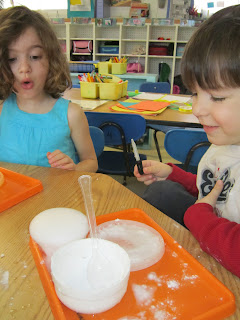Yesterday we made Irish soda bread to eat today for a St. Patrick’s Day snack. At first the children were worried because as one little boy explained, “I’m not allowed to drink soda!”
After reassuring them that the soda being used was very different from soda POP, several children helped make the bread. After making it, we talked about whether or not it had “soda” in it and what the bakers noticed about the soda.
Because they were so curious about this mysterious powder, I quickly pulled out two enormous bags of baking soda and stopped on my way to work this morning to purchased two industrial size jugs of vinegar. It is important when children are making discoveries that they have access to a lot of materials and can recreate the experiment several times.
I set up the experience giving each child his own work space and materials. I explained to the children that they could experiment with the baking soda and the vinegar to see if they could figure out why we would want it as an ingredient in our bread. I showed them putting some baking soda on a lid and then adding the vinegar. I did not show them the reaction. I simply left it with, “I wonder what you will discover?”
At first the children were fairly tentative putting small amounts of baking soda on their trays and adding the vinegar in small amounts. They noticed the bubbles and the powder “puffing up” and “getting bigger.”
What was amazing was watching the children watch each other and try to duplicate what others had discovered leading to their own experiments. We made sure not correct them or make them only do the experiment one way. They had the freedom to use the materials as they pleased on their trays.
One time a little girl wanted to freshen up her supplies so she cleaned off her tray and filled her clear cup with water (not remembering that we were using vinegar). She kept adding the baking soda waiting for the expected reaction that she had caused to happen earlier. She kept adding more baking soda to the water and absolutely nothing happened. I asked her about this. With a few open ended questions she was able to discern that she needed the vinegar. She reported to others not to get water in their cups.
And I just loved when one of my students, who I had to encourage to come over to see what we were doing, finally came. He looked at the tray and at me, and said, “This looks very dangerous. You better move!” When I asked him why he thought it was dangerous, he confirmed, “It just looks it!”
It was also exciting to see others watching their peers and being drawn in to the experience. This is when you know you have a provocative, engaging center.
We played with this for an hour today and they really didn’t want to stop. One of my students stayed there the entire time. She did all of her exploding but then moved on to creating different consistencies of dough with the ingredients and noticing the changes.
The science concepts that we were playfully learning with two simple kitchen items were endless. I am excited to see what my chemists will discover tomorrow.













I love how universal the reactions are to this! We have done some neat color mixing activities using these items... AND after inspiration from Teacher Tom we added zipper baggies! The explosions that come from that where the bag pops are so much fun to watch :). (Well, the reaction from the children!)
ReplyDelete